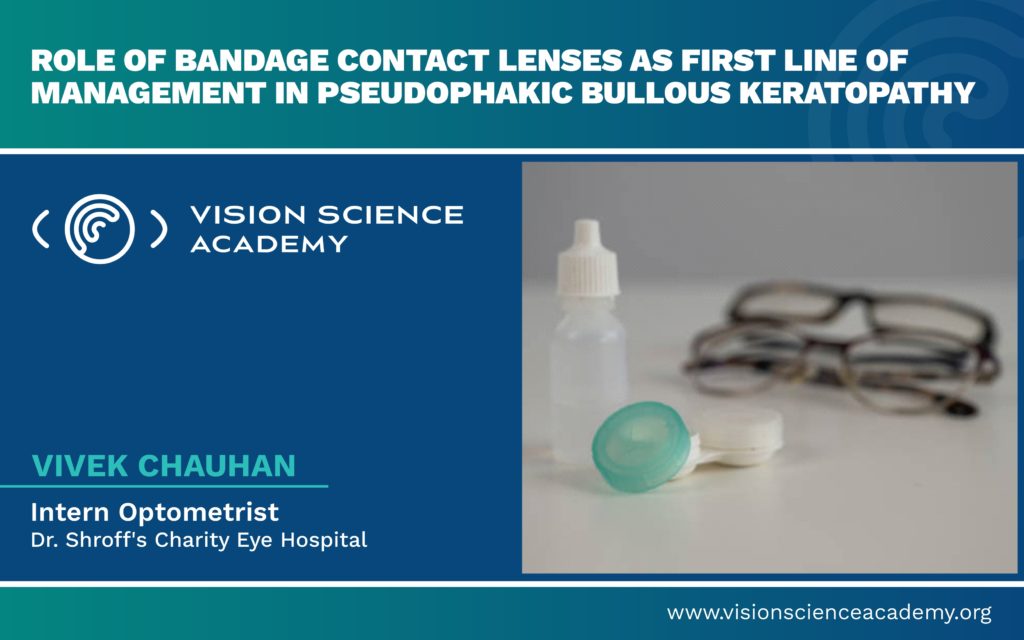Vivek Chauhan, B.Optom
Intern Optometrist, Dr. Shroff’s Charity Eye Hospital, New Delhi, India
INTRODUCTION:
Corneal oedema with epithelial bullae are often seen due to the loss of endothelial cells following cataract surgery, which eventually leads to endothelial decompensation is known as Pseudophakic Bullous Keratopathy ( PBK). It is also accompanied by abnormal deposition of the extracellular matrix . PBK is a complication of cataract surgery that is as rare as 1% to 2 % among 20 million cataract surgeries. (1,2)
PREDISPOSING FACTOR:
Fuchs endothelial corneal dystrophy, is a genetic disorder characterised by progressive loss of endothelial cells, thickening of endothelial cells and deposition of extracellular matrix which often Happens 5th to 6th decade of life.(3,4)
PREVALENCE
Prevalence of Fuchs endothelial corneal dystrophy is 3.4% where females are more involved.(4)
CLINICAL FEATURES:
SYMPTOMS
Initially, the patient’s complaint of blurry vision.
Later, when the disease becomes severe the patient presents with the following symptoms-
- Ocular pain
- Watering
- Irritation
- Discomfort
- Photophobia (5)
SIGNS
PBK has the following signs-
- Endothelial decompensation
- Loss of endothelial cells (guttae)
- Stromal oedema
- Extensive fibrosis with deposition of extracellular matrix
- Neovascularization
- Bullae
- Late phase scarring is seen.
DIAGNOSTIC TOOLS:
Slit lamp, specular microscope and Anterior segment OCT are the most commonly used diagnostic tools in clinics.
MANAGEMENT :
First line management of PBK by topical hypertonic saline (NaCl), mild topical steroid, antiglaucoma medications, anti-inflammatory topical medicines, lubricants, and PBK is managed with Bandage Contact Lenses (BCL).(6)
WHAT IS BCL :
A bandage contact lens is a soft contact lens helpful in non-infectious and post-infectious ocular surface abnormalities. Bandage contact lenses protect the cornea from environmental conditions and provide mechanical support to cornea from the counterattack of the patient’s own eyelids. Bandage contact lens does not only help in pain relief and prevent from exposure but also it helps in the healing of wounds, and epithelial regrowth.(7,8)
ROLE OF BCL :
BCL plays an important role in the management of the patient with PBK by the reduction in pain by preventing corneal bullae to direct rubbing with the eyelid while blinking and applying a pressure patch. BCL protects the cornea from exposure and further secondary infection.(6,7)
OTHER MANAGEMENT
- Puncturing anterior corneal stroma (PACS) : to get symptomatic relief from pain and destroy bullae.(1)
- Collagen cross-linking (CXL): is an effective treatment of PBK which inhibit the recurrence of bullae and oedema. (1)
- Phototherapy keratectomy (PTK): is helpful to relieve in pain by reducing the thickness of the cornea and remaining endothelial cells to maintain corneal hydration. (1)
- Conjunctival Gunderson flap: placing flap over the cornea and fulfilling metabolic demands of the cornea by increasing local blood supply and replacing dead cells. (9)
- Intrasomal human amniotic membrane grafting (AMG): helps to prevent corneal oedema and other ocular surface changes causing endothelial failure. (6)
- Partial thickness keratoplasty: transplanting partial thickness of corneal to get a good visual and symptomatic outcome, procedures are following (1,9)
- Descemet’s stripping automated endothelial keratoplasty (DSAEK). (Most common)
- Descemet’s membrane endothelial keratoplasty (DMEK). (Common)
- Full thickness keratoplasty: is the last option when all strategies fail to manage PBK then therapeutic corneal transplantation (TPK) is required. (1)
References
- Pricopie S, Istrate S, Voinea L, Leasu C, Paun V, Radu C. Pseudophakic bullous keratopathy. Romanian journal of ophthalmology. 2017 Apr;61(2):90.
- Strzalka-Mrozik B, Stanik-Walentek A, Kapral M, Kowalczyk M, Adamska J, Gola J, Mazurek U. Differential expression of transforming growth factor-β isoforms in bullous keratopathy corneas. Molecular Vision. 2010;16:161.
- Elhalis H, Azizi B, Jurkunas UV. Fuchs endothelial corneal dystrophy. The ocular surface. 2010 Oct 1;8(4):173-84.
- Allen O Eghrari and John D Gottsch, et al, Fuchs’ corneal dystrophy. HSS Public Access 2011.(PMID 20625449).
- Khan MS, Basit I, Ishaq M, Shakoor T, Yaqub A, Intisar R. Corneal collagen cross linking (CXL) in treatment of pseudophakic bullous keratopathy. Pakistan Journal of Medical Sciences. 2016 Jul;32(4):965.
- Furundaoturan O, Palamar M, Selver ÖB. Palliative Efficacy of Intrastromal Amniotic Membrane Procedure in Symptomatic Bullous Keratopathy Patients. Turkish Journal of Ophthalmology. 2022 Jun;52(3):162.
- Peter Bergenske, Jennifer L. Smythe, Et al, Bandage contact lenses help manage corneal disorders. primary care optometry 2017.
- Michael Garin. et al Bandage Contact Lenses Feb 17, 2022, Burman & Zuckerbrod Ophthalmology association P.G.
- Gurnani B, Kaur K. Pseudophakic Bullous Keratopathy. InStatPearls [Internet] 2022 Dec 6. StatPearls Publishing.
